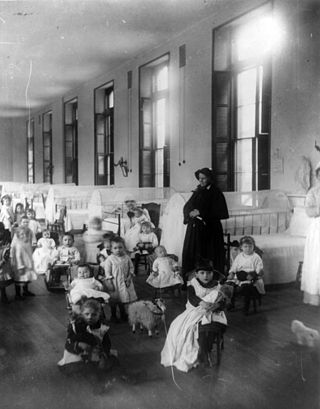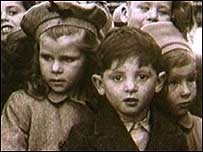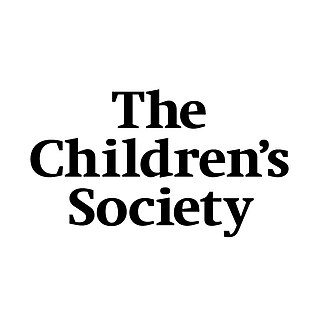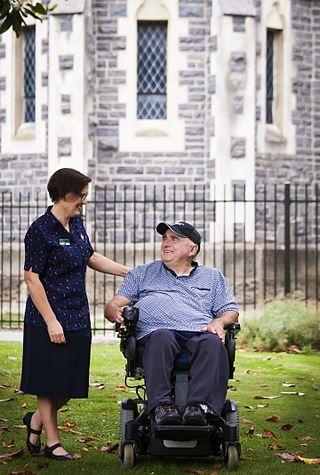Related Research Articles

Adoption is a process whereby a person assumes the parenting of another, usually a child, from that person's biological or legal parent or parents. Legal adoptions permanently transfer all rights and responsibilities, along with filiation, from the biological parents to the adoptive parents.
Baby farming is the historical practice of accepting custody of an infant or child in exchange for payment in late-Victorian Britain and, less commonly, in Australia, New Zealand and the United States. If the infant was young, this usually included wet-nursing. Some baby farmers "adopted" children for lump-sum payments, while others cared for infants for periodic payments.

An orphanage is a residential institution, total institution or group home, devoted to the care of orphans and children who, for various reasons, cannot be cared for by their biological families. The parents may be deceased, absent, or abusive. There may be substance abuse or mental illness in the biological home, or the parent may simply be unwilling to care for the child. The legal responsibility for the support of abandoned children differs from country to country, and within countries. Government-run orphanages have been phased out in most developed countries during the latter half of the 20th century but continue to operate in many other regions internationally. It is now generally accepted that orphanages are detrimental to the emotional wellbeing of children, and government support goes instead towards supporting the family unit.

Foster care is a system in which a minor has been placed into a ward, group home, or private home of a state-certified caregiver, referred to as a "foster parent", or with a family member approved by the state. The placement of a "foster child" is normally arranged through the government or a social service agency. The institution, group home, or foster parent is compensated for expenses unless with a family member.
Same-sex adoption is the adoption of children by same-sex couples. It may take the form of a joint adoption by the couple, or of the adoption by one partner of the other's biological child.
The international adoption of South Korean children was at first started as a result of a large number of orphaned mixed children from the Korean War after 1953, but later included orphaned Korean children. Religious organizations in the United States, Australia, and many Western European nations slowly developed into the apparatus that sustained international adoption as a socially integrated system. This system, however, is essentially gone as of 2020. The number of children given for adoption is lower than in comparable OECD countries of a similar size, the majority of adoptees are adopted by South Korean families, and the number of international adoptees is at a historical low.
International adoption is a type of adoption in which an individual or couple residing in one country becomes the legal and permanent parent(s) of a child who is a national of another country. In general, prospective adoptive parents must meet the legal adoption requirements of their country of residence and those of the country whose nationality the child holds.

More adoptions occur in California each year than any other state. There is domestic adoption, international adoption, step parent adoption and adult adoption.
In the United States, adoption is the process of creating a legal parent–child relationship between a child and a parent who was not automatically recognized as the child's parent at birth.
Interracial adoption refers to the act of placing a child of one racial or ethnic group with adoptive parents of another racial or ethnic group.

The Children's Society, formally the Church of England Children's Society, is a United Kingdom national children's charity allied to the Church of England.
Child protective services (CPS) is the name of an agency in many states of the United States responsible for providing child protection, which includes responding to reports of child abuse or neglect. Some states use other names, often attempting to reflect more family-centered practices, such as department of children and family services (DCFS). CPS is also sometimes known by the name of department of social services, though these terms more often have a broader meaning.

A caregiver, carer or support worker is a paid or unpaid person who helps an individual with activities of daily living. Caregivers who are members of a care recipient's family or social network, and who may have no specific professional training, are often described as informal caregivers. Caregivers most commonly assist with impairments related to old age, disability, a disease, or a mental disorder.
Effects of adoption on the birth mother include stigma and other psychological effects a woman experiences when she places her child for adoption.
The Sixties Scoop, also known as The Scoop, was a period in which a series of policies were enacted in Canada that enabled child welfare authorities to take, or "scoop up," Indigenous children from their families and communities for placement in foster homes, from which they would be adopted by white families. Despite its name referencing the 1960s, the Sixties Scoop began in the mid-to-late 1950s and persisted into the 1980s.
Until 2017, laws related to LGBTQ+ couples adopting children varied by state. Some states granted full adoption rights to same-sex couples, while others banned same-sex adoption or only allowed one partner in a same-sex relationship to adopt the biological child of the other. Despite these rulings, same-sex couples and members of the LGBTQ+ community still face discrimination when attempting to foster children.
In England and Wales, Police child protection powers concern the powers of the individual local police forces to intervene to safeguard children. These powers are governed by Section 46 of the Children Act 1989. Under this law, the police have the power to remove children to a safe location for up to 72 hours to protect them from "significant harm". Police do not require a court order to take such a step.
Forced adoption is the practice of removing children permanently from their parents and the subsequent adoption of those children, following intervention by the Children's Services department of a Local Authority in the United Kingdom.

Adoption in the Philippines is a process of granting social, emotional and legal family and kinship membership to an individual from the Philippines, usually a child. It involves a transfer of parental rights and obligations and provides family membership. The Department of Social Welfare and Development (DSWD) defines adoption as a "socio-legal process of giving a permanent family to a child whose parents have voluntarily or involuntarily given up their parental rights."
Residential child care communities or children's homes are a type of residential care, which refers to long-term care given to children who cannot stay in their birth family home. There are two different approaches towards residential care: The family model and the shift care model.
References
- ↑ Aust, Patricia H. (September–October 1981). "Using the Life Story Book in Treatment of Children in Placement". Child Welfare. 60 (8): 535.
- 1 2 3 Walker, Tony Ryan, Rodger (2003). Life story work (2nd rev. ed.). London: British Agencies for Adoption and Fostering. ISBN 1873868103.
{{cite book}}: CS1 maint: multiple names: authors list (link) - ↑ Levesque, Roger J. R., ed. (2012). Encyclopedia of adolescence. New York: Springer. ISBN 978-1441916952.
- ↑ Blake, Jo; Neil Candlish; Maureen Cavanagh; Tom Murphy; Fiona MacKirdy; Katherine Peddie; Julie-Anne Saunders; Vivienne White. "Life story work with Looked After Children" (PDF). Children Looked After Policy and Procedures. Bedfordshire County Council. pp. 1–2. Archived from the original (PDF) on 23 September 2015. Retrieved 13 December 2012.
- ↑ Rose, Richard; Terry Philpot; Mary Walsh (2005). The child's own story : life story work with traumatized children ([Online-Ausg.]. ed.). London: Jessica Kingsley Publishers. pp. 49–50. ISBN 9781843102878.
- 1 2 3 4 "Life Story Work". North Somerset Council. Archived from the original on 12 April 2013. Retrieved 13 January 2013.
- 1 2 Ryan, Tony; Walker, Rodger (2007). Life story work : a practical guide to helping children understand their past (New ed.). London: British Association for Adoption & Fostering. pp. 15–17. ISBN 9781905664023.
- ↑ Nottinghamshire County Council. "Life Story Work and Preparation for Adoption" . Retrieved 13 December 2012.
- 1 2 3 4 Goldberg, Joy Rees ; foreword by Alan Burnell ; illustrated by Jamie (2009). Life story books for adopted children : a family friendly approach . London: Jessica Kingsley Publishers. ISBN 9781843109532.
{{cite book}}: CS1 maint: multiple names: authors list (link) - ↑ Nicholls, Edith A. (2005). The new life work model : practice guide. Lyme Regis: Russell House. ISBN 1903855810.
- ↑ Fahlberg, Vera I. (2003). A child's journey through placement (New ed.). London: Jessica Kingsley Publishers. ISBN 978-1849058988.
- ↑ Kammer, Betsy Keefer and Jayne E. Schooler ; illustrated by Jack G. and Kristi Anne (2000). Mystery history : helping your foster-adopted child understand the past. Westport: Bergin & Garvey. ISBN 0897896912.
{{cite book}}: CS1 maint: multiple names: authors list (link) - ↑ "Using ICT in activities for people with dementia". Social Care Institute for Excellence. Retrieved 13 January 2013.
- ↑ Ahmad, Afshan; Betts, Bridget. "My Life Story CD Rom". British Association of Adoption & Fostering. Archived from the original on 1 March 2013. Retrieved 13 December 2012.
- ↑ Hammond, S. P. & Cooper, N. J. (2013) Digital life story work: Using technology to help young people make sense of their experiences. London: BAAF.
- ↑ Lacher, Denise B.; Nichols, Todd; May, Joanne C. (2005). Connecting with kids through stories using narratives to facilitate attachment in adopted children. London: Jessica Kingsley Publishers. ISBN 978-1843107972.
- ↑ Morgon, Roger (2006). About Adoption: A Children's Views Report (PDF). Newcastle upon Tyne, England, UK: Office of the Children's Rights Director: Commission for Social Care Inspection. pp. 28–29.[ permanent dead link ]
- ↑ Legislation.gov.uk. "Adoption and Children Act 2002: Chapter 38" (PDF). The Stationery Office, UK. Retrieved 13 December 2012.
- ↑ Department for Education. "Adoption Statutory Guidance: The Adoption and Children Act 2002" (PDF). Department for Education. Retrieved 13 December 2012.
- ↑ Telford & Wrekin Council. "4.13.4 Life Story Work". Archived from the original on 11 April 2013. Retrieved 8 February 2013.
- ↑ "Life Stories". Dementia Care. Retrieved 13 January 2013.
- ↑ Bruce, E.; Hodgeson, S.; Schweitzer, P. (1999). Reminiscing with people with dementia : a handbook for carers. London: Age Exchange. ISBN 978-0947860257.
- ↑ Gibson, F.; Carson, Y. (May–June 2010). "Life Story Work in Practice; Aiming for Enduring Change". Journal of Dementia Care. 18 (3): 20–22.
- 1 2 3 McKeown, Jane; Clarke, Amanda; Ingleton, Christine; Ryan, Tony; Repper, Julie (1 June 2010). "The use of life story work with people with dementia to enhance person-centred care". International Journal of Older People Nursing. 5 (2): 148–158. doi:10.1111/j.1748-3743.2010.00219.x. PMID 20925716.
- 1 2 Thompson, R (2010). "Realising the potential: Developing life story work in practice" (PDF). Foundation of Nursing Studies Dissemination Series. 5 (5). Archived from the original (PDF) on 14 May 2013. Retrieved 13 January 2013.
- ↑ "Life Story Work". Dementia UK . Retrieved 2013-01-13.
- ↑ "Dementia: Supporting people with dementia and their carers in health and social care" (PDF). National Institute for Health and Clinical Excellence & Social Care Institute for Excellence. Archived from the original (PDF) on 5 October 2012. Retrieved 13 January 2013.
- ↑ Ellem, K; Wilson, J (2012). "Life Story Work & Social Work Practice: a case study with ex-prisoners labelled as having an intellectual disability" (PDF). Australian Social Work. 63 (1): 67–82. doi:10.1080/03124070903464285. S2CID 141508133.
- ↑ Meininger, Herman (September 2006). "Narrating, Writing, Reading: Life Story Work as an Aid to (Self) Advocacy". British Journal of Learning Disabilities. 34 (3): 181–188. doi:10.1111/j.1468-3156.2006.00416.x.
- ↑ Thompson, R. (2010). Sanders, K.; Shaw, T. (ed.). "Realising the potential:Developing life story work in practice". Foundation of Nursing Studies Dissemination Series. 5 (5).
{{cite journal}}: CS1 maint: multiple names: editors list (link)